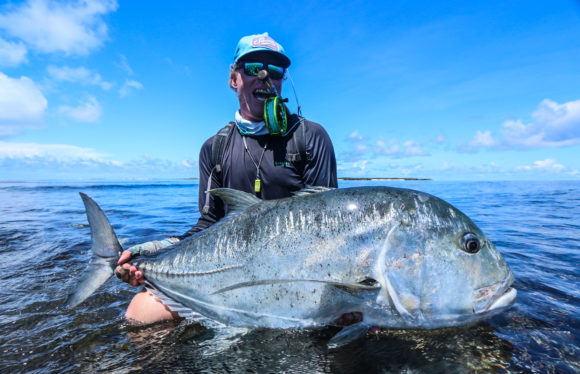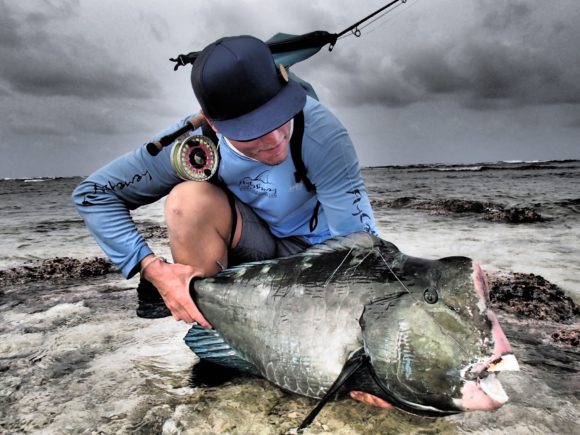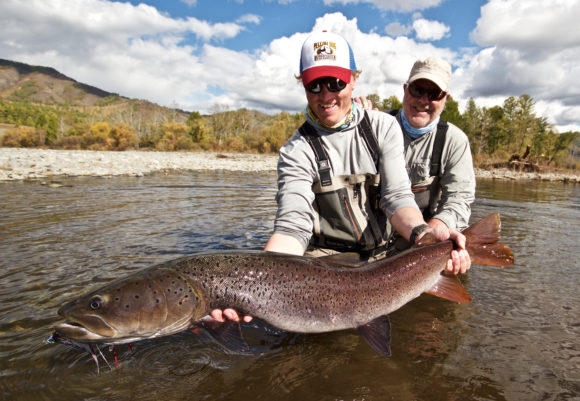Jako Lucas is an angler’s angler. A native of South Africa, Jako has fished and guided around the world. He wrote this interview after closing the season in Mongolia and before heading back to the Seychelles. He’s fished all over for all sorts of different species. He’s on the pro-staff of Yeti (read his interview with them here) and Simms. He is a travel ambassador for Yellow Dog Flyfishing Adventures. He was interviewed in The Drake (seriously, am I the last guy to talk to Jako?). He has a profile at The Venturing Angler and the Amberjack Fishing Journal. Of course, he also has Capt. Jack Productions, shooting some fine, fine video of fishy goodness. And now, he’s hit the big time and is gracing the web pages of Bonefish on the Brain. One of the more interesting reads. I hope you enjoy.

The Seychelles… that’s pretty much a dream destination. What do you think are the right reasons for an angler to head to the Seychelles? What are the wrong reasons?
What a great question. I have always told clients to come and fish the Seychelles with a very open mind, catch what you have in front of you. We have so many different species out there and they are all great targets! So many people come to the Seychelles only wanting to target one species, for example I always say clients get ‘GT fever’ – where they don’t want to catch anything else but GT’s. It is such a shame, especially when you walk past 8lb plus Bonefish, Bluefin Trevally, Triggerfish… It is always good to have a goal, but GT’s are not around all the time. You can always be ready for a GT, but if they are not there, just catch what you have in front of you, you just might like it. I regard myself as a ‘fish slut’ – I will catch anything that is in front of me and willing to eat my fly.
A client opens up his fly box on a flat in the Seychelles. What is the one pattern you wish he had, but never does?
I have always been happy to try flies that clients like to use, as you can always learn something new, but in saying that we do have some flies that are ‘tried and tested’. One of my favorite lines that we get told so many time by clients would be, “But this fly works great at Christmas Island”. Well seeing as you are in the Seychelles, that might not do the trick here… One of my favorite ‘all-round’ flies would have to be the Spawning Shrimp or similar patterns, Puglisi Shrimp or Avalon Shrimp. You can catch pretty much anything with one of these flies. Great guide teams, like the Alphonse crew, are always developing new fly patterns and the one that has been doing the most damage is the Alflexo. I also feel that clients are more and more prepared on these trips which makes the whole experience much more fun.
When you are on the water a lot you see things other folks would just never believe. What is something that fits that description you’ve seen out on the water?
You know, I think sometimes when we tell people some of these stories they might think we are crazy or making stuff up, but I have seen so many unbelievable things out on the flats, jungle or river that I have to sometimes pinch myself to make sure it is real. GT’s always get up to some crazy stuff, so I have seen them swimming full speed into shoals of huge bonefish and hit them so hard that they fly a few feet in the air and then swallow them as they hit the water. They have even smashed a Bluefin Trevally almost out of my hands as I released him. But one of the most amazing things I have ever seen, was a few years back where we found a little Island in the Indian Ocean where the GT’s where feeding on birds. At first it was hard to see or understand what was happening, as there would just be these big explosions on the water, but then we saw it clear as day. A juvenile Sooty Tern was flying low and a GT completely breached the water and grabbed the Tern by the tail. The Tern managed to just get away, but the GT did not give up and got hold of it the second time. It was still pretty hard to believe, but a little later my client hooked a tern by accident on his back cast and as the bird landed on the water it was swallowed whole by a massive GT. What we figured out later, is that these fish have through the years learnt that when the juvenile Terns learn to fly they either fly low or sometimes fall in the water… and become easy targets and these GT’s will gorge themselves on baby Terns. Nature is incredible.
There is another story I have from Mongolia. It was quite a though day on the water and we had only been connected to a few smaller fish. I moved to a pool on the river that was known for big fish, and luckily I saw a big fish cruising around that area. One of my clients, Paul, made a good cast into some slow water in the pool and the fly swung into the faster moving water. The dry fly got smoked my a good fish and it started moving around the pool and jumping. But the fish just seemed to be acting a bit strange and suddenly I saw a monster tail behind the fish. In a matter of seconds, the 30 inch fish we had on the line got upgraded to a 60+ inch fish! Definitely the biggest Taimen I have ever seen in Mongolia. So what do we do now?! The first thing that came to mind was to ‘stay down-stream’ of the fish and see if we could make sure that the big fish does not regurgitate the smaller fish. The battle went on for 10-15 minute and all we needed was just one last pull. I had the fish right in front of me. Not looking at my client’s rod angle I just heard a massive bang and the rod was in 6 pieces. The fish got below us and there was just too much pressure on the line and the 30inch Taimen was out of its mouth. We were all very disappointed, but what a epic story!

What makes a bad day of fishing on the flats?
I personally think that every day on the flats is a blessing. If someone can walk around on some of the most pristine flats in the world and not think they are in seventh heaven I think we are going to have a problem. At the end of the day everyone has to realize that when they are in these wild places it comes with certain risks. Fishing is fishing, and the more you travel and fish, the more you realize that things can always go wrong, but it is just how you handle the situation and what you take away from it. From a guiding point of view, I have always said that it is easy to be a great guide when the fishing goes off, but the best guides are the ones that come back with happy clients even after a tough day on the water.
GTs are some crazy, amazing predators. Do you remember your first? What was that like?
Giant Trevally… or as I call them Gangsters of the Flats!
Fishing for GT’s is like fishing for the most bad-ass fish in the ocean. As you may know, when you start guiding you fish very little. In fact, during the early days in the Seychelles, we had no time to fish. I guided in the Seychelles for many years, before I even thought of picking up a rod, let alone cast for a GT. I learned a lot during those years, and when I eventually got my first chance to fish I was ready. I will never forget my first encounter with a GT on the flats. I was walking on a pristine white sand flat, two monster GT’s came ‘cruising’ in line from the lagoon edge looking for Bonefish or any other unfortunate baitfish. My heart started racing, the adrenalin pumping… I managed to land the fly 10 feet in front of them and started stripping as fast as my arms would allow. Both GT’s light up and shoot towards my fly at lightning speed! As the GT’s got ready to devour my fly, the whole head comes out of the water and it looked me straight in my eyes as my fly disappears in its huge bucket shaped mouth. I took a step back and gave the GT a power strip strike to get the hook set and a few extra just to be sure. Line started peeling off my reel; my rod was buckled to the maximum, almost at its breaking point. I was lucky that the GT just stayed on the flats, and I was able to hold him there by keeping the reel on maximum drag. The stars aligned, and I got the beast to hand. Ecstasy, as I held the GT up for a quick photo and the best part of it all, for me, was to slowly let go of the tail, sending him back to his home to keep dominating the Oceans for many more years to come. That feeling of excitement, adrenaline and ecstasy applies to every GT I have caught on a fly rod.
You are from South Africa and the two biggest bonefish on record come from South Africa (although not on the fly). Why do you think that little area of your home country has produced the two biggest bonefish ever recorded?
I am so happy you mentioned this, as every time I tell clients that the world record Bonefish is from South Africa, they laugh at me… Well, I think as South Africans that is something to be pretty proud of… haha. I grew up fishing our coastline with conventional gear and as harsh as it sounds I was taught that some of the best live bait for catching GT’s from the surf is a Bonefish. So I think that we have probably not paid enough attention to them as a target in South Africa but more by catch. Unfortunately we don’t really have any flats where it is possible to target them on fly and it would simply be too hard to target them in the surf. I also think the reason why they get so big is probably because of the environment they live in and probably genetics. We have very healthy fishery on our coastlines and have really been very focused in the last two decades on, conservation, catch and release and educating the younger ones. So hopefully we see more of those big bonefish get caught in the near future, but I am sure it will be on a conventional rod.
What do you think the next great species to become popular on the fly might be and why?
I have been fortunate to be part of the pioneer work of a few new targets to come out of the Indian Ocean, for example the Bumphead Parrot fish and the Milkfish. These two fish were always seen as uncatchable, but with hard work and determination we got it done. Most of the credit for the Milkfish has to go to the Alphonse Fishing Company crew that really put in the hard yards with the Milkfish. It is amazing that you can hook a 15-50lbs fish on a 9-12wt rod and they have the ability to break anglers. Firstly they are not easy to hook, but once hooked their muscles build up no lactic acid, so they can keep going for a long time, plus they jump… a lot. Another fish that we have put at the top of the list for this year, is in the Seychelles, is the Triggerfish. If you ask any guide what his top 3 fish are in the Seychelles, a Triggerfish will definitely be right up there.

What is the best non-fishing aspect of angling travel?
There is always something exiting about the pre trip anticipation and preparation. Anything is possible, but fishing is fishing and it is never guaranteed that you will catch what you set out to, no matter what you do. I think the more and more I travel around the world, the more I have come to realized that one of the most amazing parts of the trip is the journey, the people and the different cultures. It is so easy to get completely caught up in catching fish, that one can forget to take the time to realize where you are. Enjoy every moment, relax and the rest will follow.
Who is the best guide you have ever fished with and what made them so exceptional?
That is a very hard question to answer. I have been extremely fortunate to work and fish with some amazing people in the industry. Without sounding biased, there are some really great guides from South Africa. Their passion for guiding and hard work have really made them sought after all around the world. It would be very hard for me to name them all, but I have definitely had some of my best memories out on location with my fellow countrymen. A good friend, fellow guide and mentor that I have to mention is Keith Rose Innes, he has definitely had a big impact on my guiding career. I have also been lucky enough to fish with David Mangum last year in Louisiana on a Yeti photo shoot, he was hands down one of the best guides I have ever been on the water with. His passion and obsession for the fish that he targets with his clients is next level. He has a very calm way of guiding you into a fish and you are immediately more relaxed. Loads of guides and even myself can get very animated and loud when we see a fish, but he is just calm. He also has a very affective way of helping you spot the fish, by lifting your rod facing directly in front of you and then directing you left or right. Loads of times the clock system can fail with the client looking in every direction. Also, on a recent trip to Baja Mexico, I was lucky enough to chase some Roosters from the beach with some of the industries best, Oliver White, Blane Chocklett, Christiaan Pretorius. There we also got to spend some time with Lance Peterson and you will find very few people that are more passionate and knowledgeable about the location they guide at. Someone I have always wanted to meet was Flip Pallot and 2 years ago a good friend John Wilson and owner of Cortland Fly Lines managed to arrange a day on the flats with Flip. It is definitely one of my favorite fishing trip memories!

Great read Jako. Thank for putting in the time.

